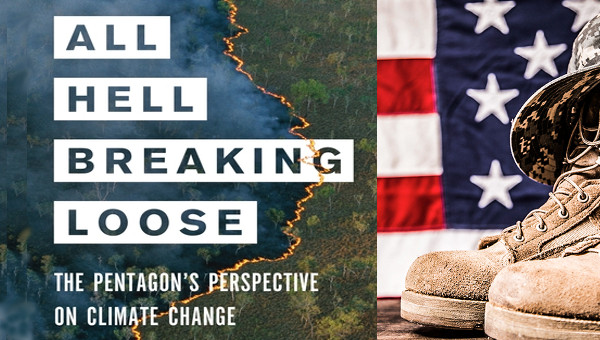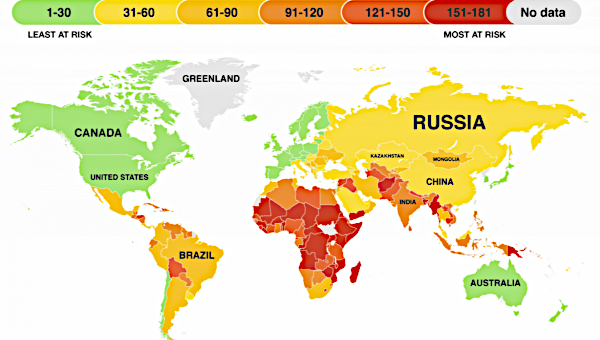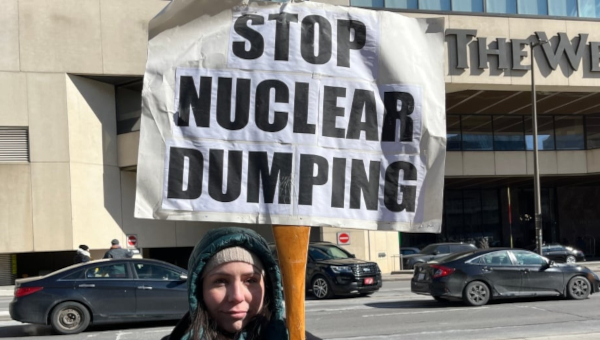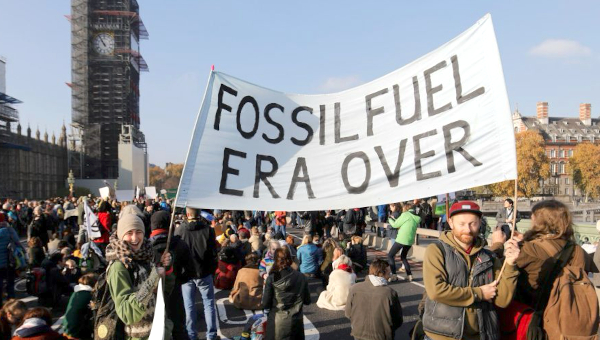Are Climate and Disaster Victims Violent?
Klare’s Paean to the American Military
Michael T. Klare’s new book, All Hell Breaking Loose: The Pentagon’s Perspective on Climate Change, is an uncritical paean to the American military. He credits the Pentagon with taking climate science seriously. But he does not question, bring contradictory evidence, or analyze the military’s self-appointed role as global manager of climate-related human disorder. Klare’s work is detailed and comprehensive and merits a close reading. He demonstrates the reach of American military power and its Hobbesian premises about human nature.

In the climate movement, there is some attention to the money spent on the military in comparison to the environment, less focus on the military’s enormous greenhouse gas emissions, and very little consideration of the implications of securitizing climate’s human impacts. I will summarize Klare’s unquestioning presentation of the military point of view, address Klare’s biases and omissions, and conclude with a psychoanalytic perspective on American militarism.
Klare’s is a military institution-centric framing with no regulatory or normative roles for local, national, regional, or international institutions. The book’s present tense title is telling: what’s just a possibility (hell breaking loose) is accepted as an inevitable reality, a law of nature. This is a closed system, and it is sealed against inquiry into causes and challenging facts. “Senior officials at the Department of Defense and the American intelligence community have peered into the future and seen this world.” The thesis is that it may be possible to mitigate and adapt to climate change but untouched here are all the systemic causes of both proliferating emissions and of human disaster. The designation “resource-deprived states everywhere” is unquestioned by Klare and by the military: unasked, who exploits the resources?
The unquestioning endorsement of the American military is especially significant in view of Klare’s previous critical work on America’s energy wars and politics. He is the defense expert for the Nation magazine and is a frequent contributor to Counterpunch, Tomgram, and Democracy Now. His new book is acclaimed by Bill McKibben (founder of 350.org) and human rights historian Adam Hochschild, and it was uncritically featured in the New York Times and The Guardian.
The Future of a Delusion
His extensive and impressive primary source material from all branches of the US military includes, for example: the multiyear Quadrennial Defense Review; the 2007 National Security and the Threat of Climate Change; the Department of Defence 2013 report Strategy for Homeland Defense and Defense Support of Civil Authorities; the 2018 Climate-Related Risk to Department of Defence Infrastructure: Initial Vulnerability Assessment Survey; the 2019 Department of Defence Report on Effects of a Changing Climate to the Department of Defense; the 2014 US IndoPacific Command Atlantic Council Roundtable; 2018 US Africa Command Public Affairs; and the 2009 US Navy Arctic Roadmap.
Klare presents a tightly managed system of policy and institutional controls that includes: Pacom (US Pacific Command), Southcom, Africom, Centcom, MIL-to-MIL collaboration (military-to-military), JTF-MIOPS (Joint Task Force Migrant Operations), HA/DR (Humanitarian Assistance/Disaster Relief), Area of Responsibility (AOR), Theater Security Cooperation Plans, Great Green Fleet, Green Warrior Convoy. The military is integrated with the NIC (National Intelligence Council), the NSA, CIA, and Customs and Border Security. These institutions of the military see climate change as a “threat multiplier” causing disorder – “hell.” The military intervenes to restore order in “stability operations,” “ungoverned spaces,” “uncontrolled spaces,” “mass migration event,” and “failed state syndrome.”
Klare describes the “professionalism” of the military. He differentiates between the “political elite” “who can say just about anything as long as they keep winning elections, and the military leadership, who are totally loyal to the chain of command and don’t speak out of turn unless they’re absolutely certain of the facts.” The military sees its primary obligation as defending the US against Russia, China and the Islamic State. But the military must now prepare for permanent combat on a climate-altered planet, with inevitable breakdown, violence and conflict: genocide and terrorism; racial, ethnic, religious and tribal conflicts; large scale atrocities; mass migration; violent resistance; outbreak of infectious diseases that could spread rapidly in crowded, unsanitary urban environments that produce widespread mayhem; danger for aid workers and tourists; looting and mob violence. The US military will be called upon to deal with complex emergencies involving “dueling ethnic militias, disintegrating governments and desperate refugees provoking new bouts of violence.”
Klare writes that Pentagon analysts see climate change “as ratcheting up global chaos, which in turn means a greater likelihood of US involvement in ugly foreign wars.” He quotes Rear Admiral David Titley, former chief oceanographer of the US Navy: “Stresses such as water shortages and crop failures can exacerbate or inflame existing tensions within or between states. These problems can lead to state failure, uncontrolled migration, and ungoverned spaces.” Missions in remote and contested areas “will not prove bloodless.”
The military assessment is that the least developed countries are resource-poor and are plagued with ethnic discord and with corrupt and authoritarian leaders. Simmering political, racial, ethnic, religious, and tribal differences will erupt into violence and mass uncontrolled migration. Competition to dam rivers and to extract fossil fuels will cause inter-state conflict and possible war for which the United States may need to use its full combat and weapons capacity to preserve order. Pakistan, Nigeria, and Saudi Arabia are of particular strategic importance to American national security and could require American military intervention.
Klare cites military and defense officials who view national security as a sacred obligation.1 Anything that might undermine institutional integrity is an existential threat. Above all else they are loyal to the unfailing integrity of the military services which they view as the ultimate bulwark against America’s adversaries. “They see climate change as ratcheting up global chaos, which in turn means a greater likelihood of US involvement in ugly foreign wars.” Storms “will impact the ability of our armed forces to fight and win our nation’s wars…” (Lt. General Norman Seip). “The United States is a compassionate, generous and caring nation with a long history of aiding those around the world who are impacted by disasters” (Admiral Kurt Tidd). Military men act out of professionalism: “It’s not an altruism thing…. There are mission reasons to do these kinds of things…” (John Conger, former undersecretary of defense). Humanitarian assistance displays the military’s compassion for victims and American military prowess, and demonstrates to allies and adversaries its ability to quickly mobilize massive resources.
To See or Not to See
After the Holocaust, there was much discussion about knowing and not knowing, though Germany’s death machine had been entirely knowable. Klare does not question or consider opposing knowledge: what kind of security would the most powerful and lethal organization in human history provide? The US military is the planet’s single largest institutional greenhouse gas emitter, while the book cover states that “a global flood of ‘climate refugees’ [and] climate-related pandemics, hurricanes, and other disasters increasingly require extensive military involvement.”
The ignored facts are that the US has started a new nuclear weapons race and could easily end all life in minutes. The US military perpetrates scorched earth wars which cast entire regions back to the stone age. Its current wars unleash terrorism. The military defoliates vast forests and strategically destroys vital health and electricity infrastructure. It commits war crimes against trapped civilian populations and justifies unconventional weapons and torture. The military terrain now includes surveillance and border security and outer space.
For Klare (and military officers), the military is professional and all but unassailable, even retrospectively. Despite decades of historiography uncovering the genocide against indigenous peoples, Klare writes that Fort Leavenworth exemplifies the military’s probity, its “legacy of the Indian Wars, when the US military established bases on [what was then] the frontier to help protect newly arrived settlers from Native American attacks….”
Crucially, does delivering supplies and evacuating people require the military? This question is timely and urgent given the Covid-19 pandemic. The US Navy hospital ship Comfort, with 1000 beds and 12 operating rooms is now deployed to New York City, but does this imply the need for the military rather than provision of essential and extensive public health funding? Klare cites examples of US military interventions in climate emergencies such as Typhoon Haiyan in the Philippines and the Ebola outbreak in West African countries. Klare does not describe the many flaws in these interventions and the alternatives for preventing the disasters in the first place. For example, Jeffrey Sachs observed how Obama chose not to appoint a world expert on Ebola but appointed “somebody who obviously lacks the necessary knowledge and experience to head an Ebola effort. This was politics.” Sachs said that the afflicted West African countries spend more on debt than on health care which could have stopped Ebola before it started, and the US could have abolished the debt.
Hurricane Maria in Puerto Rico was a “complex catastrophe.” It was compounded because relief was delayed by the US Jones Act which required that aid ships depart only from the US Corruption came from the US government side, not from Puerto Rico: Secretary of the Interior Ryan Zinke awarded a $300-million contract for reconstructing Puerto Rico’s energy sector to Whitefish Energy, a small company located in his Montana hometown. The Electric Power Union in Puerto Rico succeeded in lawfully breaking the contract (here, here and here).
Klare accepts the military framing of the “migratory impulse” and the “anti-migrant” duties of the military (p. 171). “Like it or not, [the military] will be called upon to reinforce the border and repel climate refugees.” But this is in violation international refugee law. In January 2020 the UN Human Rights Committee ruled in a landmark decision, based on an individual’s inherent right to life, that refugees cannot be sent back home.
Putin is held responsible for “detonating” “global system shocks” (p. 98) by halting Russian wheat exports when much of the harvest was lost due to heat and drought. Russian and Chinese ambitions for extraction in the Arctic are interpreted as a threat to the United States, while there is no critique of US claims, or that the climate emergency indicates that there should not be any Arctic offshore drilling. Russian and Chinese increased military spending is concerning, but is it not a reaction to US provocations – NATO expansion, missile defense, US abrogation of nuclear weapons agreements, encirclement and war games up to the borders of both countries?
He writes “land grabs” in quotes and states that this is derisive terminology about the transfer of “poorly documented tribal lands” to large American agribusinesses which boosts productivity. This is a surprising statement given the substantial documentation of land confiscation and displacement of small-scale farmers and of research showing the superiority of “subsistence” and local multi-crop agriculture and agroforestry. Agribusiness , has been a disaster to farmers worldwide, to global food production, to biodiversity and nutritional value, and is a major greenhouse gas emitter in its destruction of carbon sinks and its carbon-intensive distribution networks. Agribusiness, pharmaceuticals, and weapons are linked in cross-applications and in mega-mergers and government contracts.
Klare warns of inevitable water-wars in the climate-impacted world of water-shortages. Yet most water conflicts are resolved through negotiation. Parties to water conflicts are generally not desperate people vying with each other for life-saving water but ordinary people vs. corporations backed by states and by financial institutions.
Disasters and resource poverty do not inevitably cause conflict and breakdown. There is a long historical record of communal organizing in the face of disasters to ensure food and shelter: in Hurricanes Katrina, Maria, Sandy, the displaced 20 million flooding victims in Pakistan, the Haiti earthquake, and the Sri Lanka tsunami. Wars and military interventions in the Middle East have led to violence and breakdown where people previously co-existed and where there had been public education and healthcare.
Klare writes of the military’s green initiatives. The Great Green Fleet demonstrates “US leadership in the development of advanced energy systems and their application to military purposes.” “We are transforming our energy use to make us better warfighters…” To represent the military as green leaves out that there is no accurate accounting of the military’s entire emissions and that the military is still exempt under the Kyoto Protocol. Its life-cycle total emissions would include war-fighting technologies, its data centres, military bases, destroyed carbon sinks, reconstruction of bombed sites, militarized borders.
The military/climate nexus was first linked and publicized in the 2003 Pentagon Report. The $100,000 report was commissioned by DoD planner Andrew Marshall. Klare does not clarify that Marshall had worked for RAND, Kissinger, Nixon, and subsequent presidents and was a proponent of Missile Defense, the Project for a New American Century, and Full Spectrum Dominance. The world view of the co-authors Doug Randall and Peter Schwartz: “humans fight when they outstrip the carrying capacity of their natural environment. Every time there is a choice between starving and raiding, humans raid.”2
Fear and Pathologies
Psychoanalytic treatment often reveals a pathogenic belief underlying a person’s difficulties, around which character is formed.3 Extrapolating from individual psychology to groups is inevitably complex and speculative. Groups of people working on the same project can function with a relatively objective view of reality or on the basis of various pathogenic beliefs. In Klare’s sources, there is an unquestioned, consistent conviction articulated in policy statements and by officials that disorder and chaos will erupt with climate change and that only the American military can bring about any order. There is no inquiry into causes. The military fears climate change especially as it can impair military operations. It fears that the majority world is inherently disorganized, uncontrolled, corrupt, tribal, dirty, violent, ignorant, resource-poor, and backwards. This core belief implies that the military itself is not violent or disordered; even the first nuclear weapons test which risked vaporizing the planet, or Hiroshima and Nagasaki and the firebombing of cities, were apparently not seen as frightening or disordered because they were under the planned and intentional control of the military. In response to chaos, the military maintains a rigid hierarchical, obsessively manages minutia, and fosters omnipotent weapons and omniscient intelligence technology.
Psychologically, defensive omniscience and omnipotence allays helplessness and fear, but defenses interfere with the capacity to realistically observe oneself and the outside world.4 Military omniscience implies that everything can be known about other people’s minds through surveillance and torture, AI, algorithms, games theory, neuroimaging. Soldiers themselves are depicted as appendages of tools and who act according to protocols: US forces “rush into the country, cross borders, rappel down from helicopters, parachute out of airplanes” to secure known or suspected nuclear storage sites. The Army’s Natick Soldier Research, Development and Engineering Center is testing a “knee harvester” that collects kinetic energy from each stride to provide instant power generation on long-range missions. Instead of being able to think for themselves, it is assumed that soldiers even need instructions to drink and rest in hot weather conditions. The religious terms “sacred” and “mission” suggest a supra-human calling and sub-human capabilities.
It is instructive to read Eric Schlosser’s Command and Control about the spectacular failure of elaborate fail-safe plans when an accident at a nuclear missile silo came close to triggering a nuclear apocalypse but for the ability of a worker to think in a terrifying situation and to care about the life of a fellow worker.
In pre-algorithmic, games theory thinking, Tolstoy wrote of people’s “passions, desires, remorse, humiliations, sufferings, outbursts of pride, fear, and enthusiasm” – and how all that can be lost in one brief battle. Elderly, experienced General Kutuzov was upset, dissatisfied, depressed, and humbled by uncertainty and the unknowability of something as complex as war; he did not defensively resort to feelings of omniscience and omnipotence. Tolstoy also wrote of key pathologies in group psychology: “was it really not possible for Kutuzov to state his views [opposing battle] to the Emperor? Is it possible that on account of court and personal considerations tens of thousands of lives… must be risked?”5 In the American military decision-making group, it does not seem possible to consider that historically, militaries cause misery and augment disorder. Where are the possibilities of dissent? And why is the climate movement not dealing with this?
The current American military’s pathogenic belief is a delusion centered on a fear that is not reality tested against evidence. Their fear powerfully motivates action. Rivetted attention is on order and control, not on an examination of the fear itself. What is particularly dangerous is that this delusion is not kept as a thought but is acted out by the increasingly totalitarian military. Interventions aim to be “quick in/quick out,” as long as it takes to restore a semblance order. Ensuing disorder becomes a call for even more thorough efforts at control. It’s a frightening worldview: even the most advanced weapons systems can dysfunction in the face of sandstorms and extreme weather.
The military is embedded and sanctified in a nation wealthy enough to attempt the folly of full spectrum global dominance while failing to provide the essentials for its citizens. Facts about the military are known and easily accessible, so the silence about the climate/military nexus is alarming when fascistic militarization is increasingly globalized. Non-military publicly controlled institutions and impacted communities are well able to provide essential regulations, disaster relief, and protections for all people. •
Endnotes
- Among them: General Joseph F. Dunford Jr., Chairman of the Joint Chiefs of Staff, General Gerald Galloway, Lieutenant General Norman Seip, Rear Admiral David Titley, US Secretary of Defense Chuck Hagel, Admiral Samuel J. Locklear, formerly Marine General and Secretary of Defense James Mattis, General Gordon R. Sullivan, General John F. Kelly, Admiral Donald L. Pilling, Marine General Anthony C. Zinni, General Thomas D. Waldhauser, Admiral Philip S. Davidson, White House Chief of Staff John Podesta, Admiral Kurt Tidd, Marine Corps General Robert Neller, Acting Secretary of Defense Patrick Shanahan, Secretary of the Navy Ray Mabus.
- Dave Webb (2007). “Thinking the Worst: The Pentagon Report” in David Cromwell and Mark Levene, eds. Surviving Climate Change: The Struggle to Avert Global Catastrophe (London: Pluto Press), pp. 59-81.
- Joseph Weiss and Harold Sampson and the Mt. Zion Psychotherapy Research Group (1986). The Psychoanalytic Process: Theory, Clinical Observations, and Empirical Research, New York: The Guilford Press.
- J. Novick and K.K. Novick (1996). A Developmental Perspective on Omnipotence. J. Clin. Psychoanal, 5(1).129-73.
- Leo Tolstoy (1869). War and Peace. Book Three, Chapters 10 and 11.





